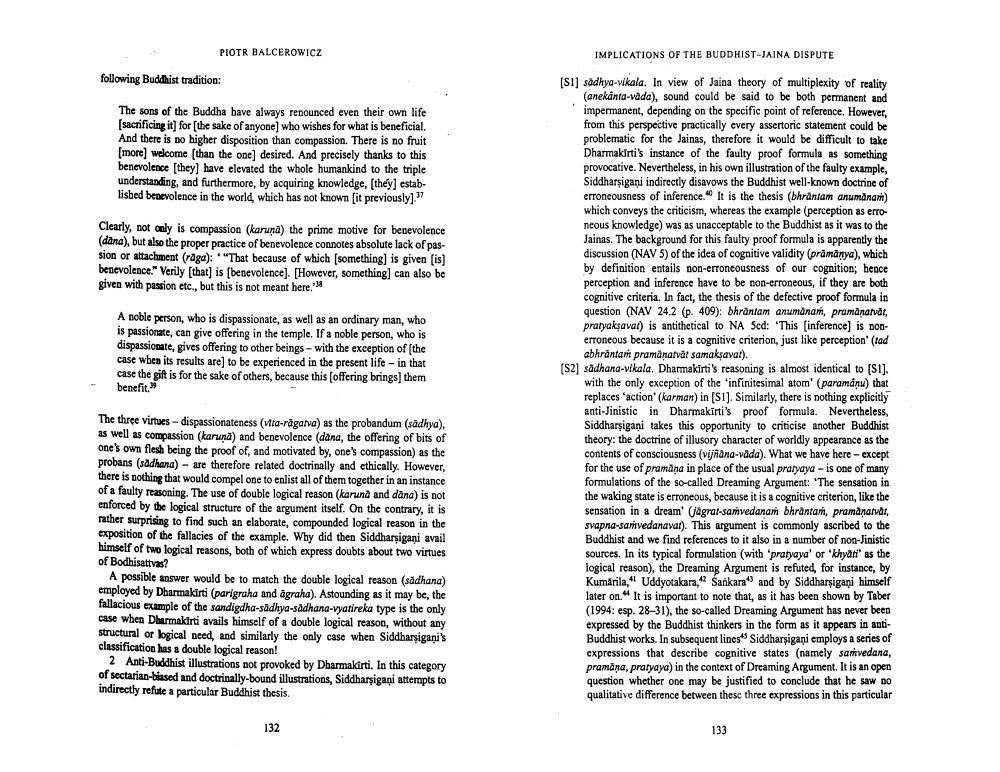________________
PIOTR BALCEROWICZ
IMPLICATIONS OF THE BUDDHIST-JAINA DISPUTE
following Buddhist tradition:
The sons of the Buddha have always renounced even their own life (sacrificing it] for the sake of anyone who wishes for what is beneficial. And there is no higher disposition than compassion. There is no fruit (more) welcome (than the one) desired. And precisely thanks to this benevolence (they] have elevated the whole humankind to the triple understanding, and furthermore, by acquiring knowledge, they) establisbed benevolence in the world, which has not known [it previously]."
Clearly, not only is compassion (karunā) the prime motive for benevolence (dana), but also the proper practice of benevolence connotes absolute lack of passion or attachment (raga): "That because of which (something) is given [is] benevolence." Verily (that) is (benevolence). [However, something can also be given with passion etc., but this is not meant here."
A noble person, who is dispassionate, as well as an ordinary man, who is passionate, can give offering in the temple. If a noble person, who is dispassionate, gives offering to other beings - with the exception of (the case when its results are to be experienced in the present life in that case the gift is for the sake of others, because this (offering brings them benefit.
(SI) sadhya-vikala. In view of Jaina theory of multiplexity of reality
(anekanta-vada), sound could be said to be both permanent and impermanent, depending on the specific point of reference. However, from this perspective practically every assertoric statement could be problematic for the Jainas, therefore it would be difficult to take Dharmakirtis instance of the faulty proof formula as something provocative. Nevertheless, in his own illustration of the faulty example, Siddharsigani indirectly disavows the Buddhist well-known doctrine of crroneousness of inference. It is the thesis (bhrantam anumanant) which conveys the criticism, whereas the example (perception as erroneous knowledge) was as unacceptable to the Buddhist as it was to the Jainas. The background for this faulty proof formula is apparently the discussion (NAV 5) of the idea of cognitive validity (pramanya), which by definition entails non-erroncousness of our cognition; hence perception and inference have to be non-erroneous, if they are both cognitive criteria. In fact, the thesis of the defective proof formula in question (NAV 24.2 (p. 409): bhrantam anumanai, pramanavat, pratyaksaval) is antithetical to NA Scd: 'This (inference) is nonerroneous because it is a cognitive criterion, just like perception' (tad
abhräntar pramanarvat samaksavat). (S2) sadhana vikala. Dharmakirtis reasoning is almost identical to (SI).
with the only exception of the 'infinitesimal atom (paramánu) that replaces 'action' (karman) in (S1). Similarly, there is nothing explicitly anti-Jinistic in Dharmakirti's proof formula. Nevertheless, Siddharsigani takes this opportunity to criticise another Buddhist theory: the doctrine of illusory character of worldly appearance as the contents of consciousness (vijiana-vada). What we have here - except for the use of pramana in place of the usual pratyaya - is one of many formulations of the so-called Dreaming Argument: 'The sensation in the waking state is erroneous, because it is a cognitive criterion, like the sensation in a dream fagrar-samvedanam bhrántani, pramanatdi, svapna-samvedanavar). This argument is commonly ascribed to the Buddhist and we find references to it also in a number of non-Jinistic sources. In its typical formulation (with 'pratyaya' or 'khyadi as the logical reason), the Dreaming Argument is refuted, for instance, by Kumarila," Uddyotakara, " Sankara and by Siddharsigani himself later on." It is important to note that, as it has been shown by Taber (1994: esp. 28-31), the so-called Dreaming Argument has never been expressed by the Buddhist thinkers in the form as it appears in antiBuddhist works. In subsequent lines Siddharsigani employs a series of expressions that describe cognitive states (namely santvedana, pramana, pratyaya) in the context of Dreaming Argument. It is an open question whether one may be justified to conclude that he saw do qualitative difference between these three expressions in this particular
The three virtues-dispassionateness (Vita-ragarva) as the probandum (sadhya), as well as compassion (karuna) and benevolence (dana, the offering of bits of one's own flesh being the proof of, and motivated by, one's compassion) as the probans (sadhana) - are therefore related doctrinally and ethically. However, there is nothing that would compel one to enlist all of them together in an instance of a faulty reasoning. The use of double logical reason (karund and dana) is not enforced by the logical structure of the argument itself. On the contrary, it is rather surprising to find such an elaborate, compounded logical reason in the exposition of the fallacies of the example. Why did then Siddharsigani avail himself of two logical reasons, both of which express doubts about two virtues of Bodhisattvas
A possible answer would be to match the double logical reason (sadhana) employed by Dharmakirti (parigraha and agraha). Astounding as it may be, the fallacious example of the sandigdha-sådhya-sadhana-vyatireka type is the only case when Dharmakirti avails himself of a double logical reason, without any structural or logical need, and similarly the only case when Siddharsigani's classification has a double logical reason!
2 Anti-Buddhist illustrations not provoked by Dharmakarti. In this category of sectarian-biased and doctrinally-bound illustrations, Siddharsigani attempts to indirectly refute a particular Buddhist thesis.
132




